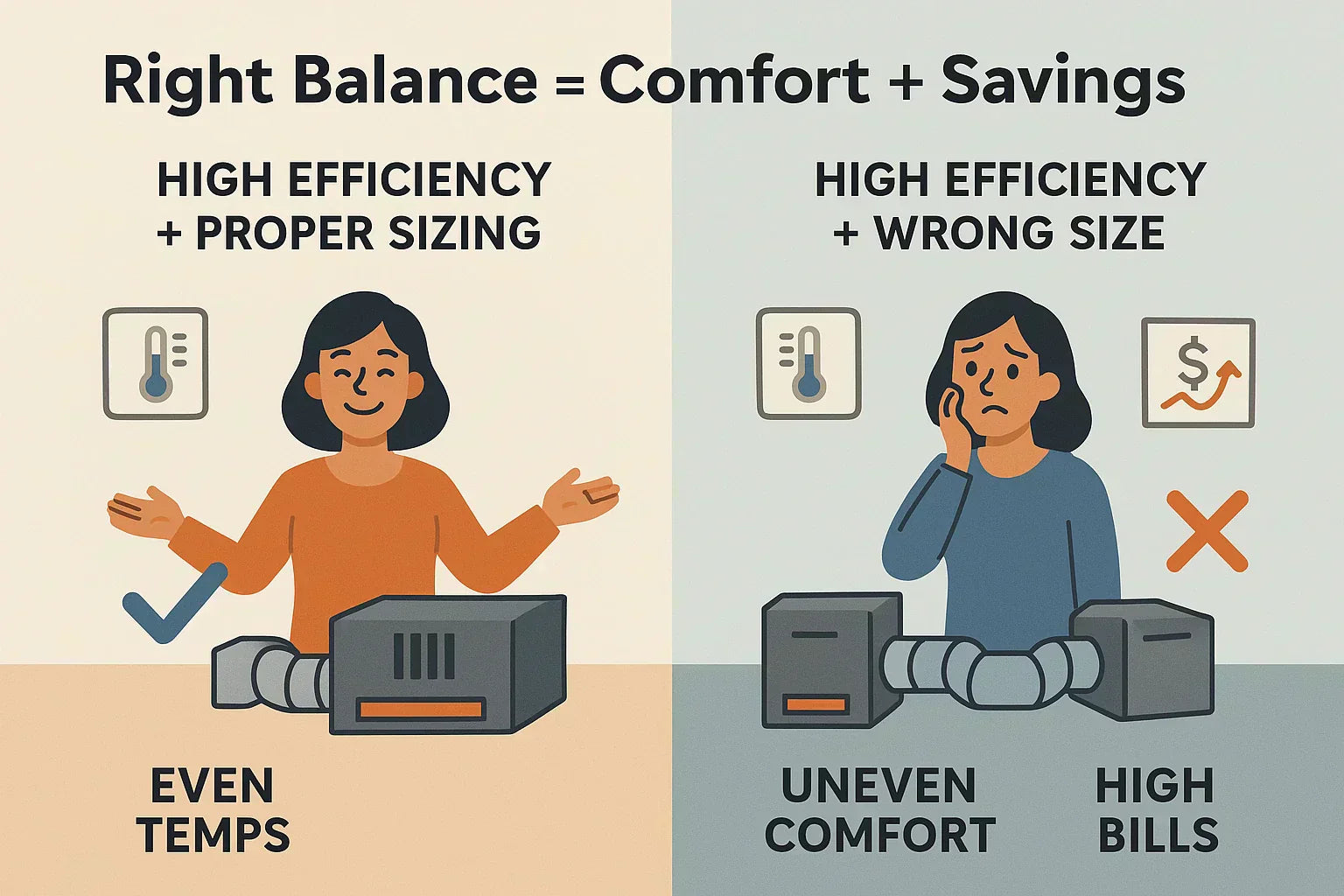When you’re shopping for a new HVAC system, efficiency ratings often take center stage. Whether it’s a high SEER2 air conditioner, a 95% AFUE furnace, or a heat pump with cutting-edge technology, the promise is always the same: lower bills and better comfort.
But here’s the question homeowners rarely ask: can an HVAC system be too efficient for its size?
The short answer: efficiency by itself isn’t the problem. The real issue happens when high efficiency is paired with the wrong system size. That mismatch can lead to wasted money, comfort problems, and premature equipment failure.
Let’s break down why efficiency must always be considered alongside proper sizing. For the basics on sizing, see our main guide: How to Size an HVAC System for Your Home.
What Efficiency Really Means in HVAC Systems
Efficiency ratings measure how much heating or cooling output you get compared to the energy you put in.
-
AFUE (Annual Fuel Utilization Efficiency): How efficiently a furnace converts fuel into heat.
-
SEER2 (Seasonal Energy Efficiency Ratio): How efficiently an AC or heat pump cools under updated test conditions.
According to the U.S. Department of Energy, higher ratings mean lower energy use under lab conditions. But those ratings assume proper system sizing and installation.
That’s where the disconnect happens. A 20 SEER2 air conditioner isn’t guaranteed to save you money if it’s the wrong size for your home.
The Problem With Oversized “Efficient” Systems
Bigger isn’t always better, even if the unit is rated as high efficiency.
Short Cycling and Wasted Energy
Oversized systems cool or heat your home too quickly, then shut off—called short cycling. This on-off pattern is inefficient and strains equipment.
The DOE warns that short cycling increases energy use, even on high-efficiency models, because systems never run long enough to hit their optimal performance zone.
Humidity and Comfort Issues
Air conditioners also remove humidity from the air. But an oversized unit won’t run long enough to dehumidify properly. The result? Clammy air, foggy windows, and higher risks of mold.
The EPA stresses that controlling humidity is essential for healthy indoor air quality. If your efficient AC is oversized, you’ll feel cool but sticky.
Increased Wear and Tear
Every startup cycle puts stress on motors and compressors. Oversized systems cycle more often, which shortens their lifespan.
According to ASHRAE, frequent cycling accelerates wear and increases repair needs—so oversizing can cost you more in the long run.
Undersized but “Efficient” Systems: A Different Risk
Some homeowners think going with a smaller, high-efficiency unit will save them money. But undersizing is just as risky.
A too-small system will run constantly, trying to keep up. Even if it’s rated 95% AFUE or 20 SEER2, it won’t perform efficiently under heavy strain. You’ll face:
-
Higher energy bills.
-
Uneven comfort across rooms.
-
Faster equipment breakdowns.
The Whole Building Design Guide on High-Performance HVAC emphasizes that both oversized and undersized units waste energy and create long-term problems. The solution is proper right-sizing before efficiency upgrades.
Finding the Balance: Sizing + Efficiency Together
Why Manual J Matters
Efficiency numbers are meaningless if the system isn’t sized correctly. That’s why professionals use Manual J load calculations to determine the correct capacity.
The Air Conditioning Contractors of America (ACCA) developed Manual J as the gold standard. It considers square footage, insulation, windows, orientation, and occupancy. If your contractor doesn’t use it, you’re not getting a true efficiency match.
When High Efficiency Pays Off
High-efficiency systems are an excellent investment when:
-
Your home is well insulated and sealed.
-
You live in an area with high utility rates.
-
You plan to stay in your home for 10+ years.
In these cases, the added upfront cost pays for itself in reduced bills.
When Mid-Tier Efficiency May Be Smarter
Sometimes a mid-efficiency unit (like a 15–16 SEER2 AC or 90% AFUE furnace) is the better option. Scenarios include:
-
Older homes with poor insulation you can’t easily upgrade.
-
Short-term ownership or rental properties.
-
Limited ductwork capacity that can’t support larger systems.
The bottom line: efficiency only delivers value when it’s paired with the right size for your home’s load.
Best Practices for Homeowners
Here’s how to make sure you’re getting efficiency that actually saves:
-
Ask for a Manual J load calculation. Don’t accept a rule-of-thumb estimate.
-
Discuss humidity control. Comfort isn’t just about temperature.
-
Check ductwork. Leaky or undersized ducts will cancel out efficiency gains.
-
Match efficiency to your needs. Higher isn’t always better—it has to fit your budget and your home.
For the next piece in this series, see: How Ductwork Sizing Affects HVAC Performance (and Why It’s Often Overlooked).
Final Thoughts
So, can an HVAC system be too efficient for its size? Not exactly—the efficiency rating itself isn’t the problem. But when efficiency is mismatched with system size, you lose the very benefits you’re paying for.
The smartest move is to balance efficiency with proper sizing. A well-sized, mid-tier system will outperform an oversized “super-efficient” unit every time.
Remember: comfort + savings = efficiency + right size.
Alex Lane
Your Home Comfort Advocate







